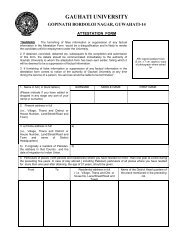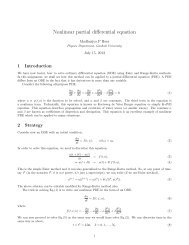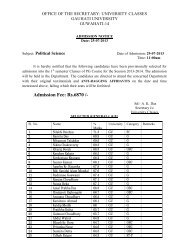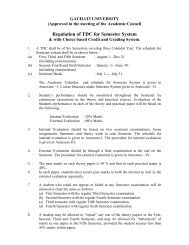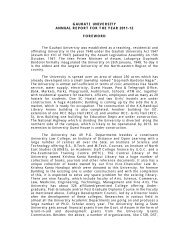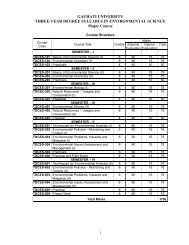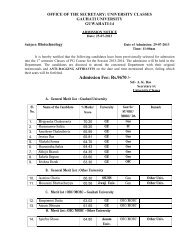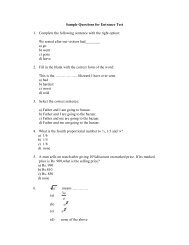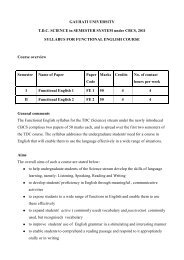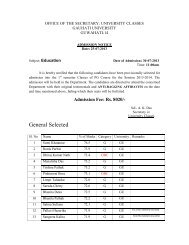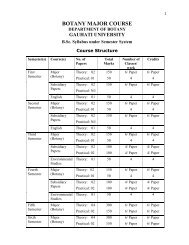QCD & Hadron Physics - Gauhati University
QCD & Hadron Physics - Gauhati University
QCD & Hadron Physics - Gauhati University
Create successful ePaper yourself
Turn your PDF publications into a flip-book with our unique Google optimized e-Paper software.
<strong>QCD</strong> & <strong>Hadron</strong> <strong>Physics</strong>45
Sea quark and gluonic contributions to strange baryonsMeenakshi Batra and Alka UpadhyaySchool of <strong>Physics</strong> and Material Science, Thapar <strong>University</strong>, PatialaWe treat the hadrons as an ensemble of quark-gluon Fock states, due to this, the contributionsfrom sea quarks and gluons can be studied in detail for low lying baryons. Statistical Modelhas successfully been applied to a nucleonic system to study the contributions from various seacomponents (scalar, vector and tensor) in the form of probabilities calculated in flavor, spinand color subspace for every quark-gluon Fock state. Although the presence of strange quarkmakes the situation somewhat di↵erent for other baryons from that of proton due to non-zeromass of strange quark. We calculate the multiplicities of di↵erent set of quark-gluon Fock statesto compute strange sea quark content for baryon octet especially for sigma triplet and cascadedoublet baryonic systems. The multiplicities calculated in this way are further useful to findthe di↵erent observables like magnetic moment, weak decay matrix elements and axial couplingconstant ratios. Moreover, we can gather information how the spin can be distributed among theconstituent quarks and gluons. Our results have been found to be matching with experimentaldata and other models.A higher dimensional potential model approach in the studyof Isgur-Wise function of heavy-light mesonsSabyasachi Roy and Dilip Kumar Choudhury<strong>Physics</strong> Department, <strong>Gauhati</strong> <strong>University</strong>Nambu-Goto action for bosonic string predicts the quark-antiquark potential to be V(r) = /r +r +µ 0 . The coe cient = ⇡(d 2)/24 is the universal Lüscher coe cient of the Lüscher term/r , which depends upon the space-time dimension ‘d’. We apply quantum mechanical perturbationtechnique taking linear confinement term in potential ( r) as parent and Lüscher term asperturbation, for the generation of wave function of meson by solving Schrödinger equation inhigher dimension. The wave function comes out in terms of Airy’s infinite polynomial series.With this wave function, we then study the Isgur-Wise function for heavy-light mesons and itsderivatives (slope and curvature). The dimensional dependence of our results and a comparativestudy with the results of 3 + 1 dimensional <strong>QCD</strong> are also reported.46
An improved analysis of ultra high energy neutrino-nucleoncross-sectionPijush Kanti Dhar 1 and D K Choudhury 21 Arya Vidyapeeth College, Guwahati 2 <strong>Physics</strong> Department, <strong>Gauhati</strong> <strong>University</strong>We calculate the ultra high energy neutrino-nucleon interaction cross-section by numerical evaluationtechnique with the incorporation of proper extrapolation at ultra low-x limit. We compareour results with the most recent results of some authors and find excellent coincidence, whichpinpoints the veracity of our numerical approach.Calculation of longitudinal structure function F L from <strong>QCD</strong>evolution equation upto next-to-leading order at small-xNomita Baruah and Jayanta Kumar Sarma<strong>Physics</strong> Department, Tezpur <strong>University</strong>The calculation of longitudinal structure function F L from <strong>QCD</strong> (Quantum Chromodynamics)evolution equation in next-to-leading order (NLO) at small-x is presented. The calculation ofis important for the phenomenological study of gluon distribution function inside the nucleon.Here we use Taylor Series Expansion method to solve the evolution equation for small-x and thusobtain t-evolution and x-evolution of structure functions. The calculated results are comparedwith H1 and ZEUS and results of MVV data, Block and Donnachie-Landsho↵ models.Characteristics of secondary charged particles produced in4.5 AGeV 12 C-nucleus collisionsH Khushnood 1 , Prithipal Singh 1 , Praveen Prakash Shukla 2 , and M Saleem Khan 21 <strong>University</strong> Polytechnic, Jamia Millia Islamia, New Delhi2 Depaerment of Applied <strong>Physics</strong>, MJPR <strong>University</strong>, BareillyAnalysis of experimental data obtained in 12 C-nucleus collisions at 4.5 AGeV has been carriedout. The study of the multiplicity correlations amongst the charged secondaries produced in4.5 AGeV 12 C-nucleus interactions reveals that the nature of these correlations is non linear andsuch correlations may be reproduced quite well by the second order polynomial. These findingsare in marked disagreement with those obtained by other workers in both hadron-nucleus andnucleus-nucleus collisions. It is also observed that the dependent of mean normalized multiplicityand reduced multiplicity on black, grey, and heavily ionizing particles are also non linear andthere correlations may also be reproduced by second order polynomial.47
Constraints on treating linear part as perturbation in a<strong>QCD</strong> potential modelK K Pathak 1 and D K Choudhury 21 Arya Vidyapeeth College, Guwahati 2 <strong>Physics</strong> Department, <strong>Gauhati</strong> <strong>University</strong>With Cornell Potential, one can take the advantage of choosing the linear part of the potential asperturbation with Coulombic part as parent as well as the Coulombic part as perturbation withthe linear part as parent. In this work we analyse the validity of linear part as perturbation in aspecific Potential Model with a narrow range of strong coupling constant and the constant shift c.We find in the analysis that the linear part can be treated as perturbation for a set of larger valuesof ↵ s in the range 0.4 apple ↵ s apple 0.72 with a constant shift in the Cornell potential within range of0.5GeV apple c apple 1GeV. Moreover with the same range of constant shift in the Potential, weexpect better results with Coulombic part as perturbation for apple 0.4.Form factor and charge radius of heavy light mesons in aspecific <strong>QCD</strong> potential modelNamita Sharma Bordoloi 1 , Krishna Kingkar Pathak 2 , and Dilip Kumar Choudhury 21 Cotton College, Guwahati 2 <strong>Physics</strong> Department, <strong>Gauhati</strong> <strong>University</strong>An analytical study of form factors and charge radii of B and D heavy light mesons is made usinga specific <strong>QCD</strong> potential model and the results are compared with existing experimental data andwith the predictions of other theoretical models.Non-singlet structure functionF NS2(x,t) in the DGLAPapproachNeelakshi N K Borah 1 , Dilip K Choudhury 1 , and Paban K Sahariah 21 <strong>Physics</strong> Department, <strong>Gauhati</strong> <strong>University</strong> 2 Cotton College, GuwahatiIn this work the non-singlet structure function F NS2(x,t) have been obtained by solving DGLAPevolution equation in leading order (LO) at small-x limit. Here we have used a Taylor series expansionand then the method of characteristics and Lagrange’s method to solve evolution equations.Wemake a detailed comparison of the predictions of the two methods with two di↵erentlevels of approximations.Our analysis indicates that one of the solutions of Lagrange’s methodis close to the CERN-WA-25 data at low Q 2 (Q 2 apple 10GeV 2 ) range, and the solution by theother method (method of characteristics) is compatible with the EMC data in high Q 2 range(11GeV 2 apple Q 2 ).49
Self-similarity based model of double parton distributionfunctions at LHCAkbari Jahan and D K Ckoudhury<strong>Physics</strong> Department, <strong>Gauhati</strong> <strong>University</strong>We construct a model for double parton distribution functions (dPDFs) based on the notion ofself-similarity, pursued earlier for small-x physics at HERA. The most general form of dPDFscontains total thirteen parameters to be fitted from data of proton-proton collision at LHC. It isshown that the constructed dPDF does not factorize into two single PDFs contrary to commonexpectations, but does satisfy the condition that at the kinematic boundary x 1 + x 2 = 1 (where x 1and x 2 are the longitudinal fractional momenta of two partons), the dPDF vanishes.Solution of nonlinear Gribov-Levin-Ryskin andMueller-Qui evolution equation for gluon distributionfunctionMayuri Devee and Jayanta Kumar Sarma<strong>Physics</strong> Department, Tezpur <strong>University</strong>The determination of gluon density at small-x, where gluons are expected to be dominant, is oneof the most interesting problems in perturbative quantum chromodynamics (<strong>QCD</strong>). The numberdensity of gluons becomes very high in the region of small-x. The rapid growth of gluon densityis reduced by gluon recombination (gg ! g), which leads to the nonlinear corrections in thelinear DGLAP evolution equations. Therefore at small-x the linear DGLAP evolution equationsare expected to breakdown and the evolution is given by an equation which is non-linear in gluondensity. Gribov-Levin-Reskin and Mueller-Qiu first studied the recombination e↵ect of gluonsin a non-linear evolution equation known as the GLR-MQ evolution equation using perturbative<strong>QCD</strong>. Here, we determined the gluon distribution function G(x, Q 2 ) by solving the GLR-MQnon-linear evolution equation. We have obtained the x and Q 2 dependence of gluon distributionfunction from the solution of GLR-MQ evolution equation. We have also examined the e↵ectof nonlinearity in the results since GLR-MQ equation is a combination of linear and non-linearterms. We find that with the inclusion of the nonlinear terms, the growth of G(x, Q 2 ) slows downrelative to the linear DGLAP gluon distribution. It is also clear from our results that nonlinearitiesdecrease with increasing R, where R is the correlation radius between two gluons. Our computedresults are compared with di↵erent parametrisations.51



